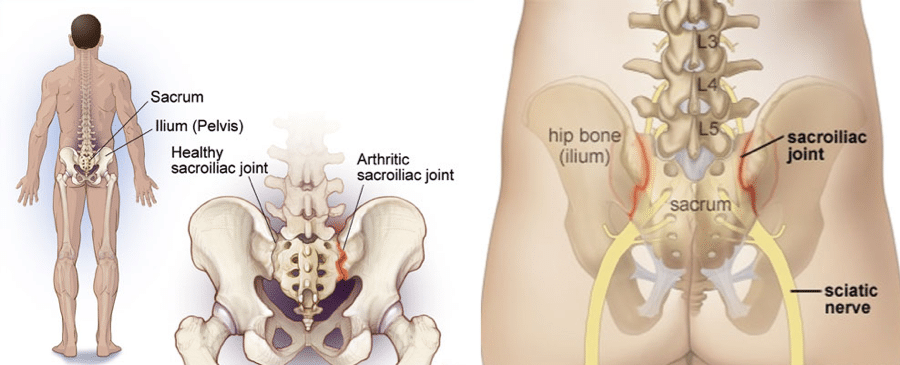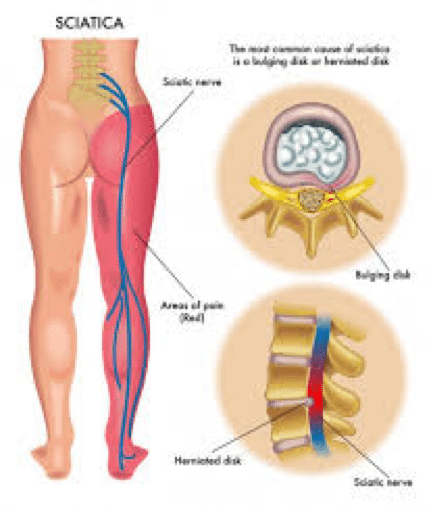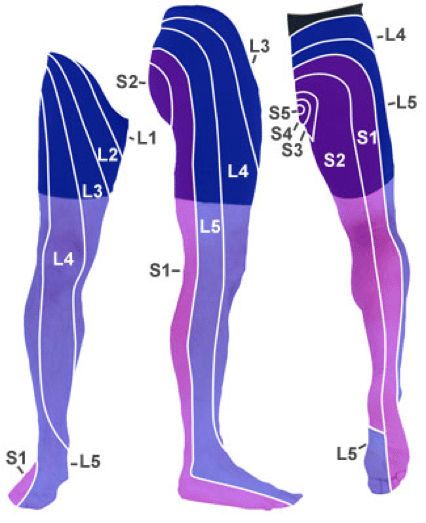Is it Sciatica or SI joint pain?
By Dr. Blessyl Buan
The word “sciatica” seems like a conversational ice breaker. I hear the diagnosis being talked about all the time like it’s something that one catches when you hurt your back. And though it is common, there is a possibility that many people claiming they have sciatica may not have it at all.
In this blog post, I will break down the anatomy of the sciatic nerve, what sciatica is and how it can be often confused for a misalignment of the SI-joint or sacro-iliac joint.
The Anatomy of the Sciatic Nerve:
The sciatic nerve is the largest nerve in the body. It originates from the branches of the spinal nerves from the 4th lumbar vertebrae to the 3rd sacral spinal nerve in the low back. As these nerves descend toward the leg, they converge to form a single nerve. The nerve exits the pelvis via the sciatic foramen, goes underneath the piriformis muscle, along the biceps femoris of the hamstring (back of the thigh). Just before it hits the fold behind your knee called the popliteal fossa, the nerve splits into two. One branch is called the tibial nerve which travels to the back of the lower leg and the foot. The other branch is the peroneal nerve which travels to the side and front of the lower leg and the foot.
The Function of the Sciatic Nerve:
The sciatic nerve provides the motor innervation for the back of the thigh and the front and back of the lower leg. When you walk, the sciatic nerve is active when you swing your leg back to lift your foot and reactivates when you push your foot to push off or land from the step. It also provides the sensory information from the skin of parts of the lower leg and foot.
Clinical Presentation of Sciatica:
At times, the sciatic nerve can become irritated and cause symptoms of radiating pain from your buttocks to your leg or foot, numbness and tingling and muscular weakness. The distribution of the symptoms will follow the dermatomal pattern that is attributed to specific spinal nerves. (see figure to the right). These symptoms are aggravated by the following: prolonged sitting or standing, coughing or sneezing. Pain can be constant or intermittent.
The cause of sciatica is multi-factorial. Below are some common causes of this issue:
Compression of the spinal nerves from L4-S3 from a herniated disc
Spinal Stenosis: A narrowing of the spinal nerve exit
Nerve entrapment under a tight muscle like the pirformis due to posture, repetitive strain or a habit of sitting on your wallet
Inflammation from arthritis or infection in neighbouring muscles
Pregnancy
Vascular issues
The Sacroiliac Joint (SIJ):
The sacroiliac joint or SI joint (SIJ) is the joint between the sacrum and the ilium bones of the pelvis, which are connected by strong ligaments. The sacrum supports the spine and is supported in turn by an ilium on each side.
Clinical Presentation of Sacro-iliac Joint Dysfunction:
The movement and alignment of the sacroiliac joint becomes dysfunctional due to posture, repetitive strain, abdominal and or pelvic floor weakness or arthritic changes. Pain can present locally or radiate to the back of the thigh stopping above the knee. SI pain can be sharp on heel strike while walking or when landing from a jump. Some symptoms will go away on their own and some can persist.
How can you tell the difference?
One key clue is how far the pain radiates. Pain from the SI joint will typically not go beyond the knee. However, the best way to investigate your symptoms is to see a licensed health practitioner that has the scope of practice, training and experience to diagnose your symptoms.
Physiotherapy and chiropractic care are effective modalities to screen for these conditions and to treat the symptoms. Whether you are a high performer, athlete, sedentary, pregnant or postpartum sciatica is common and treatable. Manage your symptoms better by booking a physiotherapy session via our online booking system today! We would be happy to help you get rid of this ‘pain in the butt’.
References:
Figure 1: https://alpinespinalrehab.com/provo-chiropractor/sacroiliac-joint-pain/
Figure 1 from www. Spineuniverse.com
Figure 2 from https://www.physio-pedia.com/Sciatica
Figure 3: https://en.wikipedia.org/wiki/Sacroiliac_joint_dysfunction





